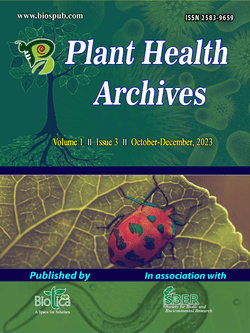
On Farm Evaluation of Trichoderma against Root Rot (Rhizoctonia solani) in Clusterbean (Cyamopsis tetragonoloba)
Sunil Kumar*
Krishi Vigyan Kendra (ICAR-DRMR), Gunta-Bansur, Alwar, Rajasthan (301 402), India
Pankaj Sharma
ICAR-Directorate of Rapeseed-Mustard Research, Sewar, Bharatpur, Rajasthan (321 303), India
Sushil Kumar Sharma
Krishi Vigyan Kendra (ICAR-DRMR), Gunta-Bansur, Alwar, Rajasthan (301 402), India
P.K. Rai
ICAR-Directorate of Rapeseed-Mustard Research, Sewar, Bharatpur, Rajasthan (321 303), India
DOI: https://doi.org/10.54083/PHA/1.3.2023/115-118
Keywords: Cluster bean, Cyamopsis tetragonoloba, Rhizoctonia solani, Root rot, Trichoderma viride
Abstract
Clusterbean, scientifically referred to as Cyamopsis tetragonoloba (L.) Taub., commonly encounters the challenge of root rot, also known as black root rot, instigated by Rhizoctonia solani, particularly in the kharif season. In fields where neither seed treatment nor soil application of Trichoderma viride were employed, the disease incidence ranged between 18.83 to 25.3%. In contrast, in demonstrated plots during the 2016 and 2017 seasons, where the seeds were treated @ 5 g kg-1 and the soil was treated @ 2.5 kg ha-1, mixed with 250-300 kg FYM and thoroughly incorporated into the field before sowing, the root rot incidence decreased significantly to 9.91 to 10.5%. Comparatively, the disease control rate of the demonstrated approach over the farmers' standard practices was recorded at 53.85%, resulting in a maximum average yield of 13.9 q ha-1. Additionally, the economic gross return and cost-benefit ratio were notably higher in the demonstrated approach (T2) @ Rs. 56,295.00 ha-1 and 3.76, respectively; while in the case of the farmers' practice (T2), it was Rs. 42,120.00 and 3.35.
Downloads
not found
Reference
Anonymous, 2016. Statistics, Directorate of Agriculture, Government of Rajasthan, Jaipur, Rajasthan. Available at: https://agriculture.rajasthan.gov.in/. Accessed on: December 25, 2022.
Bajoria, S., Varshney, A.K., Pareek, R.P., Mohan, M.K., Ghosh, P., 2008. Screening and characterization of antifungal clusterbean (Cyamopsis tetragonoloba) rhizobacteria. Biocontrol Science and Technology 18(2), 139-156. DOI: 10.1080/09583150701818972.
Dhingra, O.D., Sinclair, J.B., 1978. Biology and Pathology of Macrophomina phaseolina, Imprensa Universitária, Universidade Federal de Viçosa, Viçosa, Brasil. p. 166.
Dutta, U., Kalha, C.S., 2011. In vitro evaluation of fungicides, botanicals and bio-agents against Rhizoctonia solani causing sheath blight of rice and their integration for effective management of the disease under field conditions. Plant Disease Research 26(1), 14-19.
Glick, B.R., Patten, C.L., Holguin, G., Penrose, D.M., 1999. Regulation of plant ethylene levels. In: Biochemical and Genetic Mechanisms Used by Plant Growth Promoting Bacteria. (Eds.) Glick, B.R., Patten, C.L., Holguin, G. and Penrose, D.M. Imperial College Press, London, UK. pp. 134-179. DOI: 10.1142/9781848160521_0005.
Kumar, S., Sharma, S.K., Sharma, P., Rai, P.K., 2020. Study of White rust (Albugo candida) management approach in Indian mustard (Brassica juncea) at farmers fields through on farm testing (OFT) at farmers fields. International Journal of Current Microbiology and Applied Sciences 9(10), 3916-3921. DOI: 10.20546/ijcmas.2020.910.451.
Kumar, S., Upadhyay, J.P., 2015. Development and validation of integrated disease management (IDM) module for management of pigeonpea wilt caused by Fusarium udum. Indian Journal of Plant Protection 43(4), 493-497.
Lodha, S., Gupta, G.K., Singh, S., 1986. Crop disease situation and some new records from Indian Arid Zone. Annals of Arid Zone 25(4), 311-320.
Lodha, S., 1993. Fighting dry root rot of legumes and oilseeds. Indian Farming 43, 11-13.
Mathur, K., Shekhawat, K.S., 1987. Fusarium root rot of guar. Indian Journal Mycology Plant Pathology 17, 237.
Nasser, M.N.E., 2008. Biological Control of Root Rot of Cluster bean (Cyamopsis tetragonoloba L. Taub.). M.Sc. (Agri) Thesis, Acharya NG Ranga Agricultural University, Rajendranagar, Hyderabad. p. 263.
Papavizas, G.C., 1985. Trichoderma and Gliocladium: Biology, ecology and potential for control. Annual Review of Phytopathology 23, 23-54. DOI: 10.1146/annurev.py.23.090185.000323.
Prasad, H., 1944. Studies on the root rot of cotton in Sind. II. Relation of root rot of cotton with root rots of other crops. Indian Journal Agricultural Science 14(6), 388-391.
Rangaswami, G., Mahadevan, A., 2008. Diseases of Crop Plants in India. 4th Edition. PHI Learning Private Limited, New Delhi. pp. 275-278.
Shivran, M., Ghasolia, R.P., Choudhary, S., Gahlot, N., Choudhary, M., 2020. Management of root rot (Rhizoctonia solani) of Clusterbean through fungicides. International Journal of Current Microbiology and Applied Sciences 9(3): 3235-3239. DOI: 10.20546/ijcmas.2020.903.370.
Sindhu, S.S., Rakshiya, Y.S., Sahu, G., 2009. Biological control of soilborne plant pathogens with rhizosphere bacteria. Pest Technology 3(1), 10-21.
Upadhyay, J.P., Mukhopadhyay, A.N., 1986. Biological control of Sclerotium rolfsii by Trichoderma harzianum Sugar beet. Tropical Pest Management 32(3), 215-220. DOI: 10.1080/09670878609371066.
Yang, Q.Y., Jia, K., Geng, W.Y., Guo, R.J., Li, S.D., 2014. Management of Cucumber wilt disease by Bacillus subtilis B006 through suppression of Fusarium oxysporum f. sp. cucumerinum in rhizosphere. Plant Pathology Journal 13(3), 160-166. DOI: 10.3923/ppj.2014.160.166.
